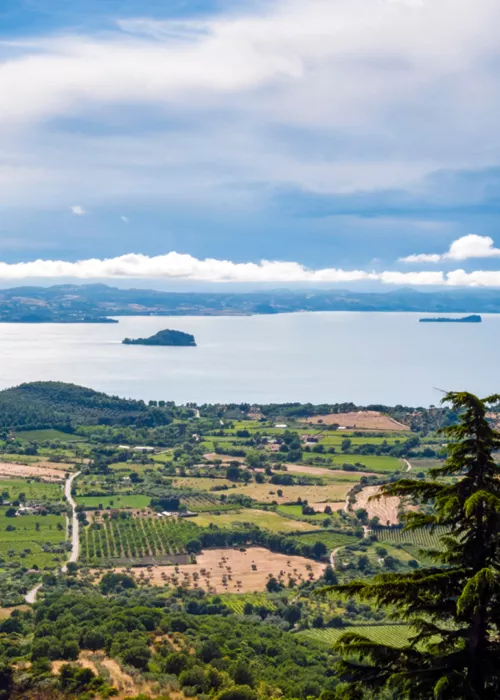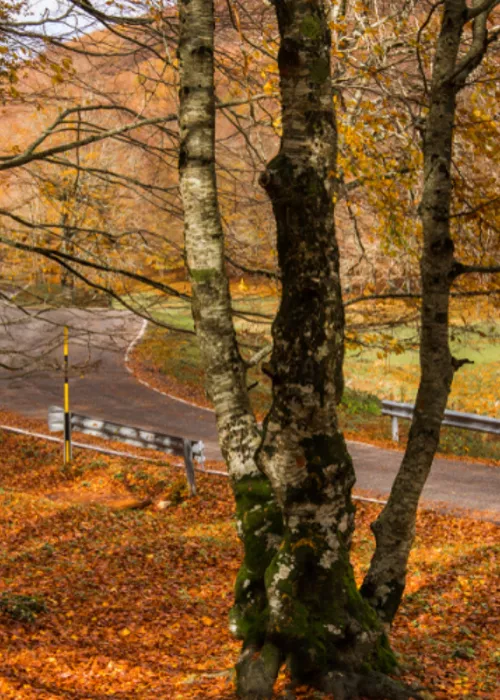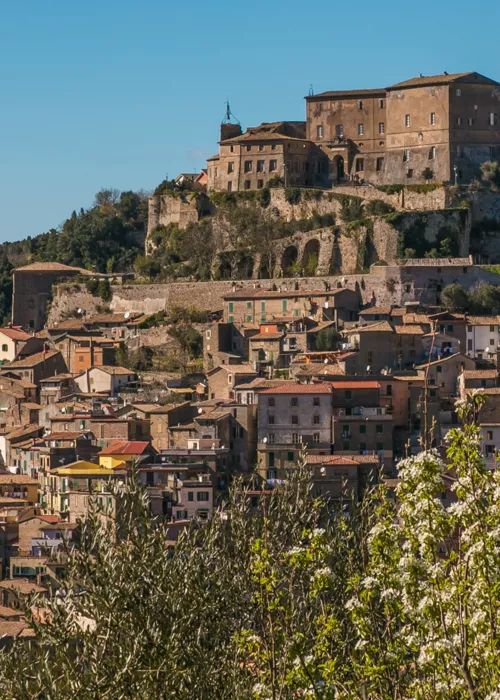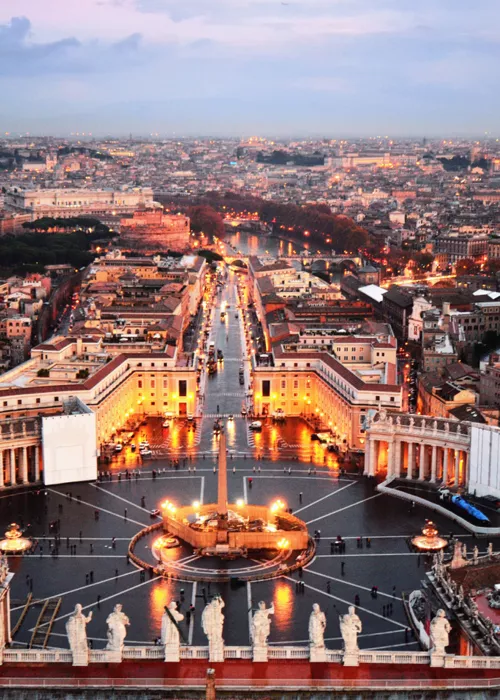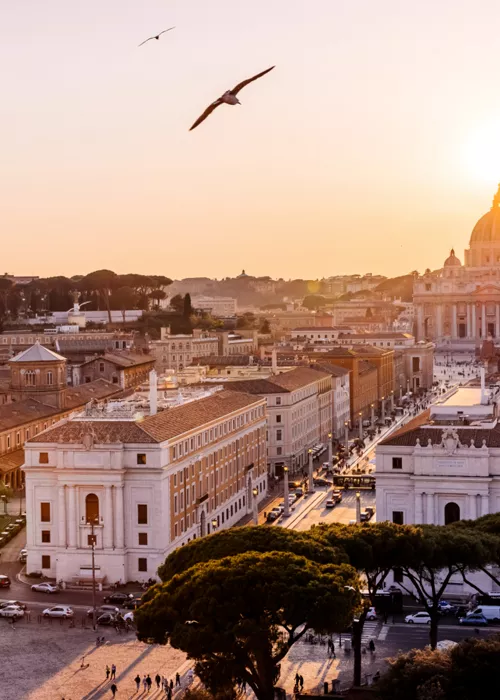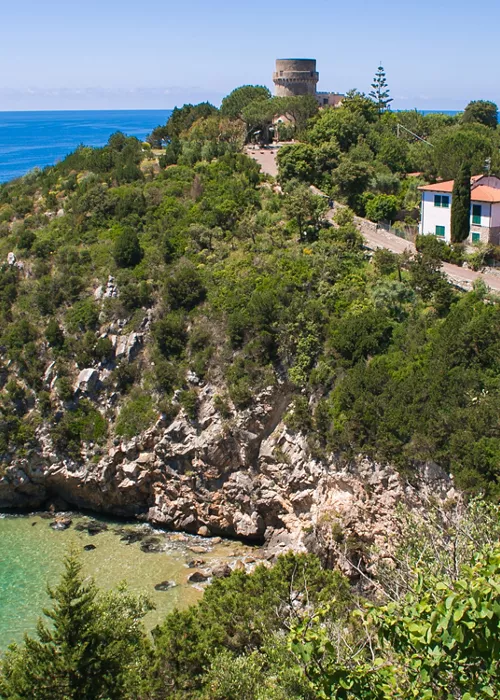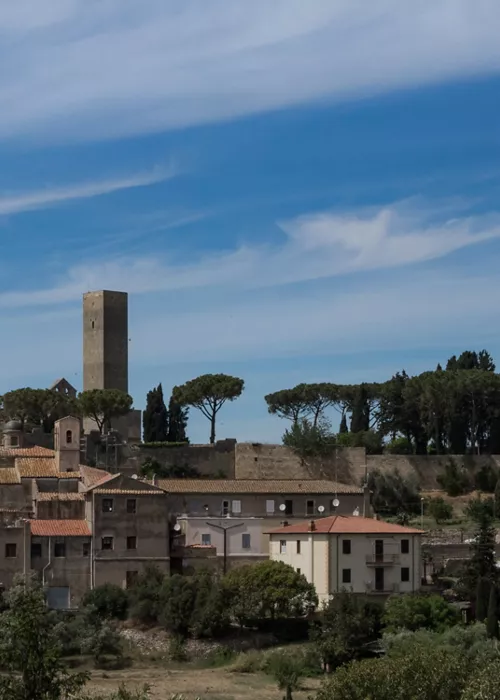Porta San Paolo

When it was built, in the 3rd century AD, the Porta San Paolo was the Porta Ostiensis for everyone. It was, in fact, the gate of the Aurelian Walls that led to the Via Ostiense, the vital connection of the City with the port of Ostia Antica. It became Porta San Paolo in the Middle Ages, when people no longer left this gate to reach Ostia, the importance of which had declined drastically, but to go and pray in the Papal Basilica of St. Paul Outside the Walls, which rises along the Via Ostiense about 2 km further on. The gateway, squeezed between two mighty towers, resembles a small medieval castle with battlements. On the outside, from its construction, it dialogues with an architecture as similar as it is different, the Pyramid of Cestius (or Pyramid of Caius Cestius), a large tomb erected in the 1st century BC on the model of the Egyptian pyramids for the Roman politician Gaius Cestius Epulon. Other tombs, much more recent, are located all around the green area of the Non-Catholic Cemetery (or Protestant Cemetery), which developed from the 18th century: at the time, there was no monumental cemetery of Verano, and the dead non-Catholics had no right to be buried inside the Aurelian Walls. On the inside, the Porta San Paolo has two arches, one of which is surmounted by a frescoed aedicule depicting St. Peter, but tradition has it that the subject was originally St. Paul. You only have to visit the Museum of the Via Ostiense, set up inside the gate, to discover that the Via Ostiense is linked to both saints. Amongst models and artefacts illustrating the historic road, the museum also holds "Christian memories" of the area. Of note are the cast of the sepulchral slab of St. Paul, found under the Basilica of St. Paul Outside the Walls, and a bas-relief depicting the embrace between Peter and Paul, from the lost Cappella della Separazione (Chapel of the Separation) and accompanied by an epigraph: Peter and Paul are said to have met and greeted each other on the Via Ostiense, at the height of today's Centrale Montemartini, before being taken to the sites of their respective martyrdoms, which occurred on the same day. Paul's, although a tradition places him on the same Via Ostiense, would have taken place a couple of kilometres away, in the Ardeatino district, where the church of San Paolo alle Tre Fontane now stands.
Centrale Montemartini

In the early 1900s, the Ostiense district became an industrial area and its factories needed electricity. Along the Via Ostiense, the Centrale Montemartini was then built: a space between the road and the Tiber was chosen about 1 km from the beginning of the road, in order to ensure both good accessibility and the possibility of drawing the water necessary to cool the systems from the river. Right there, as a plaque that was placed at the entrance of the power plant for the 1975 Jubilee recalls, once stood the Cappella della Separazione (Chapel of the Separation). The church, which was lost in 1915, honoured the exact point where, according to tradition, the extreme encounter between Saints Peter and Paul would have taken place before their martyrdom. It is no coincidence that the church of EUR, a district that rises further along the Via Ostiense, is officially called the Basilica of Santi Pietro e Paolo and pays homage to both saints.
The power station, opened in 1912, was decommissioned in the mid-1960s and recovered as a cultural space in the last part of the century. In 1997, it hosted for the first time an exhibition of ancient sculptures and archaeological finds from the Capitoline Museums, exhibited in a very special context: an example of industrial archaeology where marble statues alternate with cast iron and iron from boilers and large diesel generators. The success was such that, a few years later, the power station became a real museum, a detached section of the Capitoline Museums.
In 2016, three carriages of Pius IX's train were placed in a sector of the former boiler room, along with two precious roundels by Jean-Léon Gérôme (1856–1858), originally placed in the carriage that housed the Chapel. Pius IX boarded this train for the first time on 3 July 1859: from the Porta Maggiore station, he reached the Cecchina station in Albano. From the first carriage, a kind of balcony, the pope looked out to bless the crowd.
Basilica of St. Paul Outside The Walls

At the height of the second mile of the Via Ostiense stands the Papal Basilica of St Paul Outside the Walls, one of the oldest and noblest churches in all of Christendom, where one of the four Holy Doors that are opened on the occasion of the Jubilees is located (the others are those of St Peter's in the Vatican, St. John Lateran and St. Mary Major). In fact, this basilica honours the site of the first burial of St. Paul, the Apostle to the Gentiles: it was built shortly after the promulgation of the Edict of Milan (313 AD), the decree with which Constantine authorised Christian worship, at the behest of the emperor himself, at the same time as the Vatican basilica of St. Peter. It was consecrated by Pope Sylvester I in around the year 330 AD. St. Paul, martyred not far from here in 64 or 67 AD, had been interred in the great Ostian Necropolis, of which important traces remain near the basilica. The burial site in a Roman necropolis was made possible by the influence of a Christian matron, Lucina, and by the fact that Paul was a Roman citizen.
Even before the end of the fourth century, the basilica was rebuilt in monumental form and reconsecrated in 390 by Pope Siricius. Destroyed almost entirely by fire in 1823, it was rebuilt in full adherence to the original structure.
In the early 2000s, excavation work under the basilica brought to light the tomb of St. Paul, marked by a tombstone bearing the dedication "PAVLO APOSTOLO MART(YRI)". A window behind the Pope's altar allows you to see this tombstone. In 2009, the two thousandth anniversary of the birth of the saint, Benedict XVI announced the results of the inspection of the tomb: "traces of a precious linen fabric dyed purple, laminated with pure gold and a blue fabric with linen filaments were found. Grains of red incense and protein and chalk substances were also found […]. Very small bone fragments, subjected to carbon 14 examination, were found to belong to a person who lived between the 1st and 2nd century". In the basilica, above the column capitals runs a frieze punctuated by roundels depicting in sequence all the popes, from St. Peter to the present day.
Adjacent to the basilica is the Abbey of St. Paul Outside the Walls, where Benedictine monks have lived since the eighth century assigned to looking after the votive lamps and celebrating the liturgy at the burial place of the saint.
Ostia Antica

It is said that Ostia Antica was the first colony of Rome, founded by Ancus Martius in the 8th century BC. More likely, it was founded four hundred years later as a garrison camp for its naturalsalt pans. In any case, for a thousand years, century after century, Ostia was the "gateway" of Rome for those arriving from the sea, as well as the city that was identified with the outlet of the Tiber: ostium, after all, means both "gate" and "outlet". Its port was repeatedly expanded and rebuilt, in a grandiose manner under Trajan. Along with goods of all kinds, salt arrived in Rome from Ostia in great quantity, a precious commodity at the time. The wealth of the Roman city is seen in the excavations of the Archaeological Park of Ostia Antica, extending over 150 hectares, which today are about 3 km from the sea, and barely touching the Tiber. The geography of this area has, in fact, changed over time due to floods that changed the course of the river and the shifting of the coastline.
In the early Middle Ages, when port traffic declined, the village of Ostia Antica was not rebuilt on the site of the Roman city but at a point better defensible from Saracen raids, above a Christian necropolis that had received the remains of various saints, including St. Monica and St. Aurea. Directly above their tombs, the Basilica of Santa Aurea was built. Ostia's close connection with Christian history is attested by the fact that an episcopal see was established here as early as the 3rd century and that, traditionally, the bishop of Ostia had the right to consecrate the bishop of Rome. As many as 12 bishops of Ostia ascended to the papal throne. In the 15th century, the town of Ostia Antica was redesigned in a Renaissance style by a pope, Martin V, and a cardinal who became a pope in his turn, Giuliano della Rovere (Julius II), who rebuilt the fortifications and built the fortress known as the Castle of Julius II.
In the second half of the 16th century, everything came to an end with the flooding of the Tiber in 1557, which changed the course of the river and turned the area surrounding the village into a swamp. Ostia Antica was abandoned by its inhabitants, with the exception of a few families of farmers and salt pan workers.
Lido di Ostia

The Via Ostiense ends with a view of the Tyrrhenian Sea in front of the pier of Lido di Ostia, which is officially the "coastal district" of Rome but can, in fact, be considered a destination in itself and a sea town in its own right. For the Romans themselves, Lido di Ostia is a destination for out-of-town trips and often also a place for extended holidays. This has been the case for a hundred years, thanks to the connections provided since 1924 by the railway, which starts from Porta San Paolo (just like the Via Ostiense) and since 1928 also by the Via del Mare, built as a futuristic motorway alter ego of the ancient Roman road.
The town of Lido di Ostia is fascinating, with its Art Nouveau villas and rationalist buildings, shops and pleasant little fish restaurants, but the primary attraction is the beaches, including those in the surrounding area: they stretch for more than 10 km from the mouth of the Tiber southwards, as far as Tor Paterno, supervised by some seventy fully equipped bathing establishments.
Between relaxation, entertainment and a holiday mood, there would seem to be little room for spirituality, but this is not true. Valuable opportunities for meditation can also be found here. You can, for example, reconnect Franciscan-style with nature in the almost 1,000 hectares of the Castel Fusano pine forest, planted in the 18th century south of the town and now part of the Litorale Romano State Nature Reserve, or in the Lipu Mediterranean Habitat Centre (CHM) oasis, where over 200 species of birds sing. The latter was created in 2001 south of the mouth of the Tiber, in the area of the former seaplane base, now included in the tourist port of Rome, reclaiming what was a kind of open-air dump, infamous as the scene of Pier Paolo Pasolini's murder. Inside the oasis, the site of that heinous crime has been transformed into a literary garden, with a memorial (by Mario Rosati) depicting two doves. Almost an example of a secular resurrection, in the name of the director of The Hawks and the Sparrows and The Gospel According to St. Matthew.








